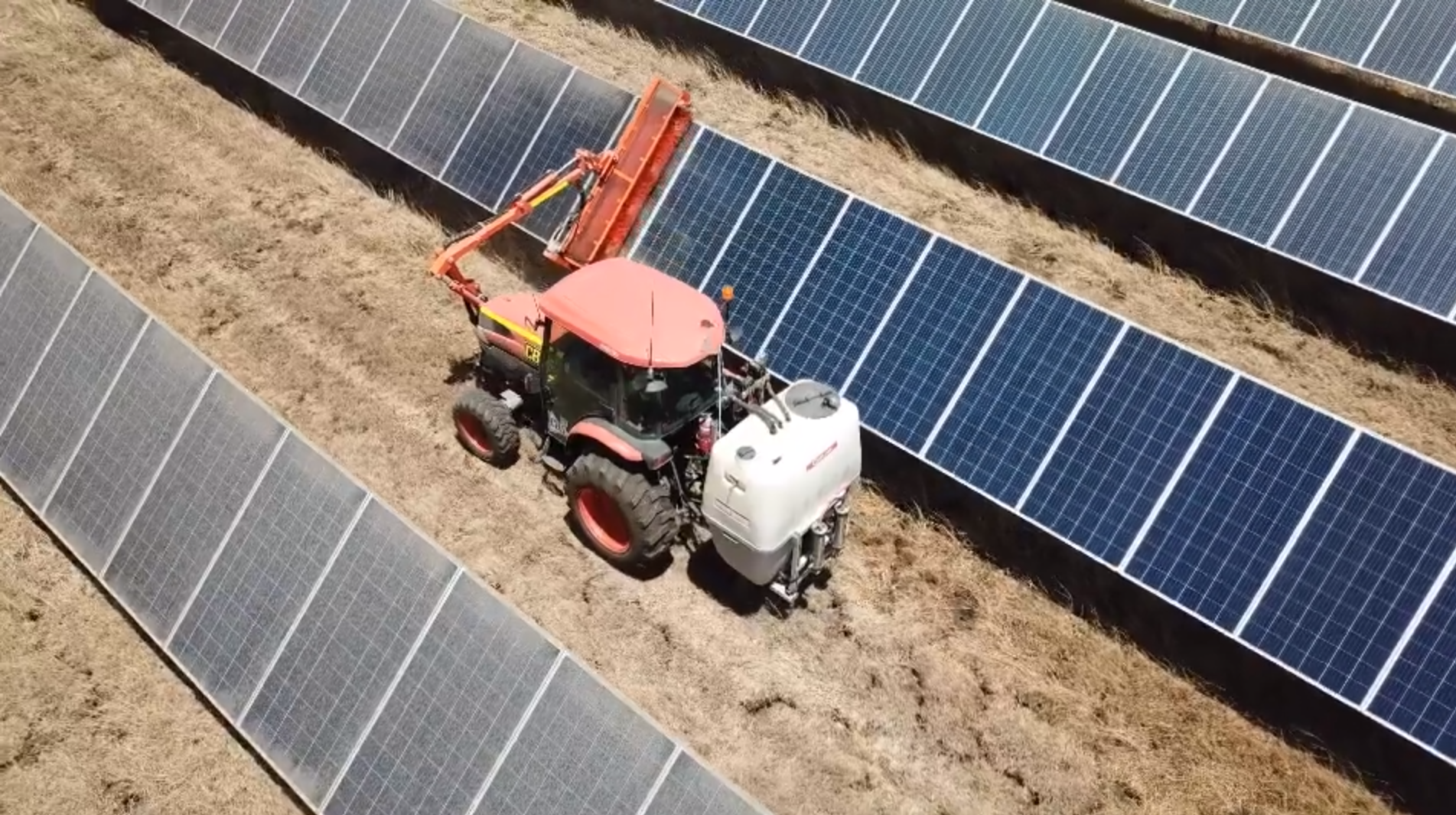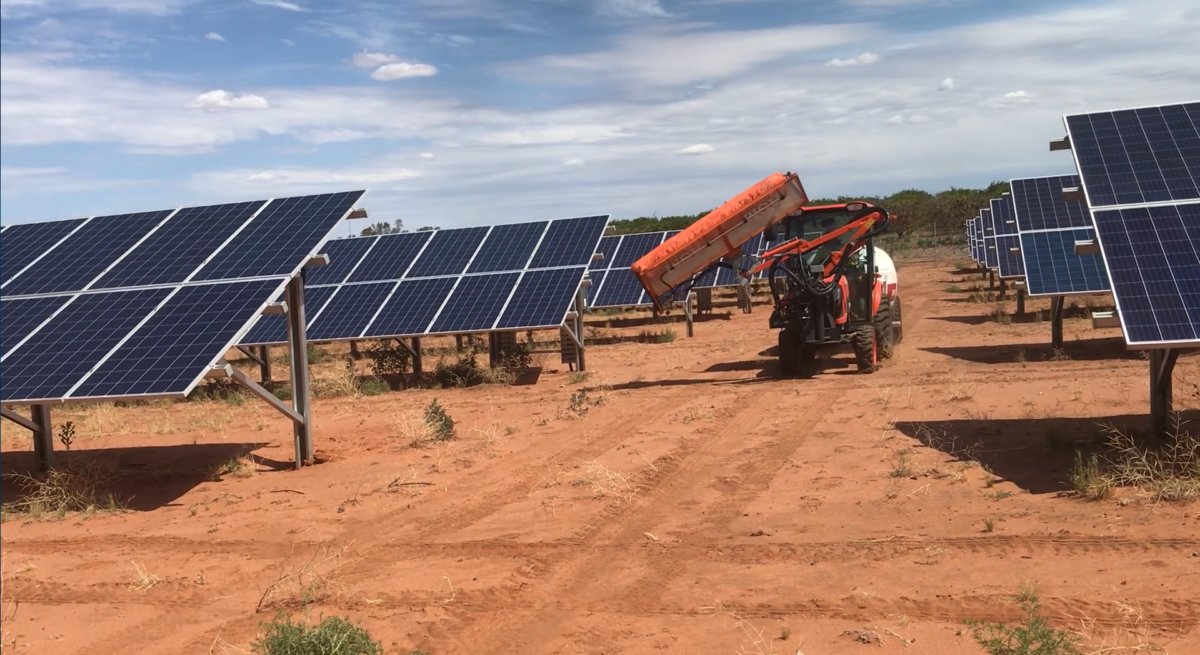pv magazine Australia: Australian Solar Maintenance (ASM) has designed vehicles to more effectively clean modules at large scale arrays. How did you decide that it was a worthwhile service for the segment?
Australian Solar Maintenance (ASM): ASM originated in small-scale residential and commercial rooftop PV system cleaning. In our peripheral vision we were monitoring the rise of large-scale PV farms earmarked for construction around Australia. Having first-hand experience and knowledge of PV module maintenance requirements, Australia needed a solution to service this evolving industrial sector and it is obviously not practical or financially viable to complete this mammoth task manually.
Can you describe the soiling impacts you see in the Australia?
The ‘life-blood’ of a PV module is solar irradiance (UV light) and therefore any foreign particle or substance on the glass face of a PV module impedes or restricts UV light absorption, restricts the PV module’s ‘life-blood’ and these impediments are called soiling – which is, essentially, shading. Soiling on large-scale PV farms [in Australia] is predominately environmental as they are located in remote locations of open, vast expanses of land. Soiling types and intensities vary depending on the geographical location of a large-scale PV farm, however the most prevalent soiling types are dirt/dust, bird soiling and flora.
A couple of examples of the varying soiling types we encounter: In the South Australian Riverland region soiling, pollen and bird soiling is caused by nearby citrus plantations, whereas Port Augusta has a heavy earth metals/dusty, clay variety of soiling, compounded by cold moisture.
Having an understanding of the geographical location and land management are very important parts of soiling management on a large-scale PV farms, but often overlooked. A balance also needs to be achieved with vegetation management, as vegetation growth, when correctly managed, compliments the PV array’s performance by reducing ground soiling and maintaining soil structure through root growth. Limited or no vegetation results in soil erosion and subsequent PV module soiling. Excessive and uncontrolled vegetation results in shading, increased fauna activity and introduces new soiling varieties.
What amount of solar yield losses are recovered with efficient cleaning? Perhaps you could provide an example?
Great question! Large-scale PV farm cleaning is relatively new to Australia and although Europe is well across the benefits in solar yield recovery through PV module cleaning, Australia is still evolving on that front and are yet to experience the ROI of large-scale PV farm cleaning services.
Studies have been undertaken in Australia to measure solar yield losses attributable to soiling with varying results. Studies at the Nyngan and Broken Hill large-scale PV farms have measured solar yield losses of between 0.16% to 0.31% per month and have stated that there are many examples of sites with soiling levels being much more significant and even exceeding 10% in some months.
Our data across small-scale residential and commercial rooftop systems has shown solar yield performance increases ranging from 3% to in excess of 30%. However, the extent of PV module soiling and the solar yield losses are highly dependent on a number of contributing factors such as geography, environment, PV array configuration, ecology, topography and the amount of annual rainfall in the region.
Regardless, all reputable PV module manufacturers have care and maintenance requirements relating to their PV modules and recommend at least an annual inspection and clean of PV modules.
Other than being spectacularly named, your Australian designed vehicle is customised with, for instance, a PV module cleaning brush-head attachment through which variable water payloads are dispensed. The design is vaguely reminiscent of Steve the ‘Ideas Man’ from the classic Aussie film, “The Castle”, who at one point invents “a brush with a hose in it.” Where did the idea for ASM’s vehicles come from?
As large-scale PV farms continued to flourish and grow across Australia, the need for PV module cleaning needed to keep pace. ASM needed to develop a better, faster, safer and more economical way of cleaning hundreds of thousands of PV modules on a large-scale PV farms and our manually operated water fed poles were just not going to achieve this.
ASM spent approximately two years researching various technologies and vehicles around the globe that would be suitable for our idea. In our research we also noted the various challenges other model vehicles had been encountering whilst operating in the large-scale PV farm environment and we designed these issues out of our vehicles.
Where did ASM’s vehicle models names, Sheila, Gazza and Bazza, come from?
Our vehicles are an Australian first and we wanted to retain the Australian origins and identity, coupled with our larrikin nature, so we decided to name each vehicle we build with an affectionate ‘Aussie Slang’ name.
What distinguishes Sheila, Gazza andBazza from other solutions in the market? What aspects of the vehicles’ versatility allow them to overcome challenges faced by other vehicles?
ASM carefully considered all aspects of the vehicle design from operator and asset safety, ergonomics, component drive control system, water flow rates, water purification systems, brush head material and the important need for a nimble, versatile and robust vehicle to accommodate the varying large-scale PV Farm configurations operating in some extreme and isolated environments.
Fundamentally, a clear line-of-operator sight, ease and comfort of vehicle control, narrow body configuration and water conservation were very important aspects in our design.
ASM’s vehicle components have been designed, engineered and manufactured locally in Australia, leveraging our knowledge and experience of the variable and extreme environments the vehicles will be subjected to operating in.
How does ASM conserve water compared to its competitors?
ASM understood from the onset how precious water is and how logistically challenging and costly it can be to mobilise water on a large-scale PV farm, so water conservation was a key feature in our design. ASM has incorporated a water flow rate system which can be adjusted to meet specific large-scale PV farm cleaning water requirements depending on the level and type of soiling. The water flow rate can be changed in minutes to accommodate the specific large-scale PV farm requirements. Our vehicles have a baseline water flow configuration of 4.5 Litres per minute, compared to some vehicles which operate at a flow rate of 30 Litres per minute. 
Is there a minimum or a maximum limit to the size of solar farms ASM can service?
Although ASM vehicles are capable of cleaning smaller ground mounted PV arrays, they are ideally designed for PV farms of 1 MW plus. There are no maximum limits on the size of a solar farm as numerous ASM vehicles can be deployed across a single solar farm to meet client schedules.
Furthermore, ASM recently completed a ‘special project’ to design a vehicle capable of cleaning PV modules on a fixed PV array at a reach of eight metres, which culminated in the construction of ‘Bazza’. So ASM has the capability to design and build vehicles to meet some challenging PV array configurations also.
How long do you think the vehicles, and components, will last?
ASM vehicles and components have been designed and specifically selected to endure the harsh environments and work they are subjected to. The pedigree of our selected vehicle (Kubota tractors) has been tried and tested around the globe providing confidence in its robustness. Our steel fabricated vehicle components are manufactured by a supplier that specialises in the defence industry, that mandates durability and our brush head material selection is used in the agricultural industry for cleaning fruit and vegetables on a commercial scale, without damaging produce.
All these aspects of our vehicle design ensure our vehicles have many years of uninterrupted operation, and in the unlikely event of a breakdown, ASM’s strategic approach of in country design, fabrication and assembly, enables ASM to respond quickly.
Which parts of Australia is ASM currently operating in? And where do you see ASM operating in the future?
ASM currently has vehicles operating in Central Queensland and South Australia with new opportunities continually arising as large-scale PV farms are commissioned and the awareness of PV module cleaning grows to mitigate the financial and ROI implications of solar yield losses.
ASM has fielded enquiries right across Australia relating to our vehicles and is engaged in discussion with Germany, Saudi Arabia, India, Pakistan and the United States.
Are there any developments or partnerships in the solar PV industry that ASM is particularly excited about?
ASM follows closely most developments across the PV industry, locally and internationally. The continued rise of large-scale PV farm construction around the globe is particularly exciting as ASM are on the ‘ground-floor’ with a solution to meet the PV module cleaning requirements of a solar farm for its 30-year-plus lifecycle.
ASM is also excited about the developments in PV module technology evolution and large-scale PV farm construction techniques, which drive ASM to adapt to meet evolving market requirements. One example of ASM evolving to meet construction techniques, is the variation in infrastructure in the construction of tracker configurations and the challenges faced by above ground cable trays. ASM’s vehicles have been adapted to safely navigate these configurations, with fixed water payloads, in cab control for directional boom arm change (right or left) and brush head rotation directional change. The PV industry continues to provide exciting challenges for ASM and the evolution of our vehicles.
What do you make of the international interest?
Our original plan was to construct and operate our vehicles across Australia on large-scale PV farms, however the Australian and international interest in purchasing ASM vehicles has presented potential supply opportunities globally. So, like the evolution of our vehicles, ASM is now looking to evolve beyond the borders of Australia.
This content is protected by copyright and may not be reused. If you want to cooperate with us and would like to reuse some of our content, please contact: editors@pv-magazine.com.









By submitting this form you agree to pv magazine using your data for the purposes of publishing your comment.
Your personal data will only be disclosed or otherwise transmitted to third parties for the purposes of spam filtering or if this is necessary for technical maintenance of the website. Any other transfer to third parties will not take place unless this is justified on the basis of applicable data protection regulations or if pv magazine is legally obliged to do so.
You may revoke this consent at any time with effect for the future, in which case your personal data will be deleted immediately. Otherwise, your data will be deleted if pv magazine has processed your request or the purpose of data storage is fulfilled.
Further information on data privacy can be found in our Data Protection Policy.